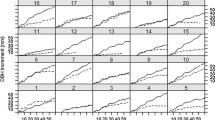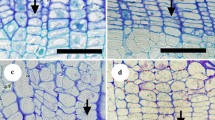Abstract
Baldcypress saplings were subjected to two flooding regimes of continuous and periodic inundation for three years to allow comparison of annual ring characteristics. Basal stem discs were examined for the number and nature of intra-annual response features, such as false rings. The formation of latewood was also compared for trees from each flooding regime. Radial growth was significantly greater in saplings from the continuously flooded treatments for years 2 and 3. No significant difference was found between treatments for the total number of response features present; however, periodically flooded saplings developed a significantly higher number of major false rings. Trees from this regime also consistently produced a greater number of thick-walled, latewood-type cells associated with false rings and annual rings.
Similar content being viewed by others

Literature Cited
Beaufait, W. R. and T. C. Nelson. 1957. Ring counts in second growth baldcypress. Journal of Forestry 55: 588.
Bowers, L. J. 1981. Tree ring characteristics of baldcypress growing in varying flooding regimes in the Barataria Basin. Louisiana. Ph.D. Dissertation. Louisiana State University, Baton Rouge LA, USA
Broadfoot, W. M. 1967. Shallow-water impoundment increases soil moisture and growth of hardwoods. Soil Science Society of America Proceedings 31: 562–564.
Broadfoot, W. M. and H. L. Williston. 1973. Flooding effects on southern forests. Journal of Forestry. Sept. 1973: 584–587.
Dickson, R. E., J. F. Hosner, and N. W. Hosley. 1965. The effects of four water regimes upon the growth of four bottomland tree species. Forest Science 11:299–305.
Duever, M. J. and J. M. McCollom. 1987. Cypress tree-ring analysis in relation to wetlands and hydrology. p. 249–260.In: G.C. Jacoby, Jr. and J.W. Hornbeck (eds.) Proceedings of the International Symposium on Ecological Aspects of Tree-Ring Analysis. U.S. Department of Energy Publication CONF-8608144.
Eggler, W. A. and W. G. Moore. 1961. The vegetation of Lake Chicot, Louisiana, after eighteen years impoundment. The Southwestern Naturalist 6: 175–183.
Fritts, H. C. 1965. Growth rings of trees: their correlation with climate. Science 154: 974–979.
Fritts, H. C. 1976.Tree Rings and Climate. Academic Press, New York, NY, USA.
Goyer, R. A. and G. J. Lenhard. 1988. A new insect pest threatens baldcypress. Louisiana Agriculture 31: 16–17.
Goyer, R. A., G. J. Lenhard, and J. D. Smith. 1990. Insect herbivores of a bald-cypress/tupelo ecosystem. Forest Ecology and Management 33/34: 517–521.
Hook, D. D., O. G. Langdon, J. Stubbs, and C. L. Brown. 1970. Effect of water regimes on the survival, growth, and morphology of tupelo seedlings. Forest Science 16: 304–311.
Hosner, J. F. and S. G. Boyce. 1962. Tolerance to water saturated soil of various bottomland hardwoods. Forest Science 8: 180–186.
Larson, P. R. 1956. Discontinuous growth rings in suppressed slash pine. Tropical Woods 104: 80–99.
Larson, P. R. 1963. The indirect effect of drought on tracheid diameter in red pine. Forest Science 9:52–62.
Megonigal, J. P. and F. P. Day. 1992. Effects of flooding on root and shoot production of bald cypress in large rhizotron cells. Ecology 73: 1182–1193.
Stahle, D. W., E. R. Cook, and J. W. C. White. 1985a. Tree-ring dating of baldcypress and the potential for millennia-long chronologies in the southeast. American Antiquity 50: 796–802.
Stahle, D. W., M. K. Cleaveland, and J. G. Hehr. 1985b. A 450-year drought reconstruction for Arkansas. United States. Nature 316: 530–532.
Stahle, D. W., M. K. Cleaveland, and J. G. Hehr. 1988. North Carolina climate changes reconstructed from tree rings: A.D. 372 to 1985. Science 240: 1517–1519.
Stahle, D. W., R. B. VonArsdale, and M. K. Cleaveland. 1992. Tectonic signal in baldcypress trees at Reelfoot Lake. Tennessee. Seismological Research Letters 63: 439–447.
Stokes, M. A. and T. L. Smiley. 1968.An Introduction to Tree-ring Dating. The University of Chicago Press. Chicago, IL, USA.
Zahner, R., J. E. Lotan, and W. D. Baughman. 1964. Earlywoodlatewood features of red pine grown under simulated drought and irrigation. Forest Science 10:361–370.
Author information
Authors and Affiliations
Rights and permissions
About this article
Cite this article
Young, P.J., Megonigal, J.P., Sharitz, R.R. et al. False ring formation in baldcypress (Taxodium distichum) saplings under two flooding regimes. Wetlands 13, 293–298 (1993). https://doi.org/10.1007/BF03161295
Received:
Revised:
Accepted:
Issue Date:
DOI: https://doi.org/10.1007/BF03161295



